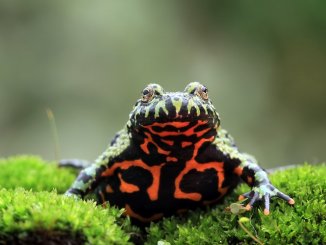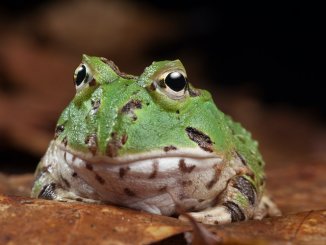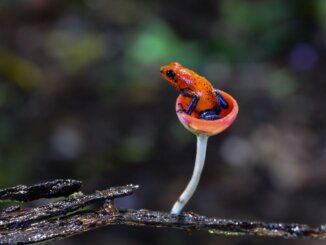The leopard frog is found in many areas of the world, including Canada, Mexico, the United States, and parts of Central America. Leopard frogs get their name from the leopard-like spots on their bodies that are usually situated on their backs. These frogs come in all shapes and forms, and “leopard frog” is an umbrella term for a variety of different species and types of frog.
Leopard frogs make popular and fascinating pets. These frogs are easy to care for, but like any other pet, need proper maintenance and care. This leopard frog guide will discuss the important points to consider before bringing home a new pet frog.
Leopard Frog Overview

Before you think about bringing home a leopard frog, start by learning some of the basic facts about leopard frogs.
|
|
|
|
|
|
|
|
|
|
|
|
|
|
|
|
Leopard frogs are some of the easiest types of frogs for a beginner to keep and can be a great introduction to frog keeping.
Origin
The leopard frog (Lithobates genus) is found in Mexico, Central America, Canada, and the United States. Leopard frogs are very common and live in a variety of different habitats. The Northern Leopard frog, for example, can be found in swamps, slow-moving streams, ponds, and marshes. Southern leopard frogs are found in similar environments, preferring wet, damp, marshy burrows.
While leopard frogs are relatively common, their numbers have declined in recent years. This is due to habitat destruction, the introduction of new fish and animals into the leopard frog’s habitat, and human intervention.
Appearance and Behavior
Because leopard frogs come in different species and sizes, their appearance can vary. The most distinctive markings on a leopard frog are its dark, circular, “leopard” spots.
One of the most popular pet frogs is the northern leopard frog, which has brown spots and bright green coloring. Southern leopard frogs are also popular pets but not quite as popular as northern leopard frogs. The southern leopard frog is olive green or light brown in color, with noticeable dark spots. Southern leopard frogs are timid and more likely to hide.
The color, size, and pattern of the spots can vary between leopard frogs. However, the trademark spots are always there.
There are differences between most male and female leopard frogs. This can vary depending on the species of frog. In northern leopard frogs, the males are slightly smaller than the females and have a pair of vocal sacs for their mating calls.
Size and Lifespan
The average adult leopard frog grows to between 3 and 5 inches in length. The lifespan of a leopard frog can vary, depending on the species. A northern leopard frog can live up to 12 years in captivity with proper care and maintenance.
Temperament
Leopard frogs are mild, non-aggressive pets. These frogs are timid and can be easily startled. Although they aren’t territorial or aggressive, leopard frogs will try and eat anything they can fit in their mouths. This includes other smaller frogs, so you shouldn’t house a leopard frog with any other animal small enough to eat.
It’s safe to handle leopard frogs with care. However, most species of leopard frogs (northern and southern leopard frogs included) don’t enjoy being handled. A leopard frog’s fondness for human attention will depend on the frog’s temperament and whether the frog is used to being handled. Beware of leopard frogs’ powerful hind legs. Leopard frogs can jump around 3 feet if they feel threatened.
Most species of leopard frogs can be housed together without territorial or aggressive behavior. However, you should make sure that your enclosure has plenty of space for the number of frogs you’re planning to house.
Housing Leopard Frogs
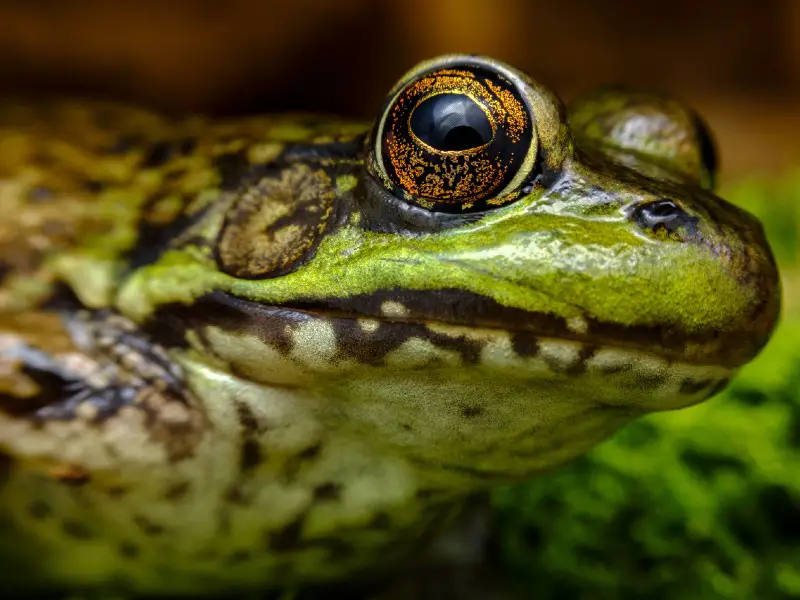
In the wild, leopard frogs live in a variety of habitats including wet, marshy areas of woodland, forests, and slow-moving streams. Leopard frogs are semi-aquatic, meaning that they will need a water area in their enclosure along with a dry area.
Frogs can be kept in terrariums or vivariums. Ideally, you should buy an enclosure suited for reptiles and semi-aquatic animals. Your enclosure should be able to sustain proper heating, water, and substrate.
Enclosure Size
For a single leopard frog, a 10–20 gallon tank will be fine. If you plan to add more frogs, add an extra 10 gallons for each new frog.
Floor space is much more important for frogs than height. Narrow, tall tanks are inappropriate for leopard frogs because these animals don’t climb much. Leopard frogs need a land area and water area, so you’ll need to create two distinct sections of the tank.
Lighting
Leopard frogs are nocturnal, so UV lighting or any kind of lamp really isn’t necessary. However, some owners choose to put lighting in their tanks to give their pets a proper day/night cycle..
If you add a lamp to your leopard frog enclosure, make sure that your frogs can’t jump on the lamp and get burned.
Frogs will hide if the lighting in the enclosure is too bright. If you notice that your frogs are often hiding, you should reassess the lighting in the enclosure.
Temperature and Humidity
During the day, keep the temperature in the tank at 70 to 75°F. You can create different temperature gradients by creating cooler areas in the tank and by adding a basking area of 80 °F.
Use heating pads, heat emitters, and heat lamps to create warm areas in the tank. The larger your tank is, the easier it will be to create different areas of temperature.
In the wild, leopard frogs deal with temperature drops overnight. To mimic this, you can drop the temperature in the tank to 60 °F. Leopard frogs are cold-blooded, and a cooler nighttime period will help the frogs regulate their internal temperature.
Humidity is another consideration for a healthy and happy leopard frog. The humidity in the enclosure should be 50-70%. You can use an automatic fogger or a spray bottle to spritz the inside of the tank with warm water occasionally. If your frogs need more humidity, they can go into their water area. Hydrometers are a good way to measure a tank’s humidity.
Substrate and Decoration
With substrate and decoration, it’s good to mimic your leopard frog’s natural habitat as closely as possible. Organic potting soil is a popular substrate choice.
You can add reptile bark and peat moss to create different textures on the substrate. Leopard frogs like to burrow, so make sure you have at least 3 inches worth of soil.
Avoid gravel or any other kind of scratchy substrate with small pebbles. Your leopard frog could accidentally eat small pebbles or bits of stone, and gravel is harsh and likely to cause injuries and abrasions. However, you can use gravel as the very bottom layer of the enclosure, with several inches of substrate on top.
For decorations, provide pieces of wood, caves, and live terrarium plants. Non-toxic, low-lying plants create cover and hiding places for your frogs and add extra oxygen to the air. Pieces of smooth wood can be used to create easy access points from the water area to the earth area.
Make sure that your decorations are smooth, with no jagged points or splinters, so that they won’t injure your frogs.
Cleaning
Frogs are messy animals, and it will take persistent cleaning to maintain a clean tank. Cleaning a leopard frog’s enclosure can be divided into two parts: the water, and the earth.
You can clean out the water part of the enclosure by doing 50% water changes daily and using an old toothbrush to wipe away any algae or dirt build-up along the sides of the water area. A water siphon can be used to suck up dirt from the bottom of the water area and siphon out the dirty water.
You should perform spot cleans every week for the earth area and a full clean every two weeks. You’ll need to clean more frequently if you have lots of frogs.
Start by taking out your frogs and putting them to one side in a safe space. You can put your frogs in another small enclosure if you have one, or put them in a small plastic or styrofoam cup. Make sure your frogs can’t knock over their cups and escape. For a spot check or water change, you can leave your frogs in their tank.
Check live plants for decay, fallen leaves, or rot, and remove dying leaves. Spot check the substrate and scoop out dirty spots like uneaten food, dead insects, or frog skin.
For a big clean, take out and replace most of the substrate. Unless there’s illness or some kind of mold in the tank, it’s fine to leave some substrate behind. If the gravel at the very bottom of the tank has algae or looks dirty, scoop it out and rinse it through a colander, using an old toothbrush to scrub it.
Wipe down the walls of the tank with a reptile-safe spray or warm water. You should never use bleach, baking soda, or any kind of commercial cleaning product to clean out your frog tank. These products contain chemicals and can hurt or kill your pets.
You can get special tank-cleaning products designed for frogs and reptiles, but if in doubt, use warm water and a clean soft cloth.
Replace the gravel, and put a generous layer of substrate on top. Replace the decorations, which should also be rinsed and scrubbed in warm water.
Leopard Frog Care
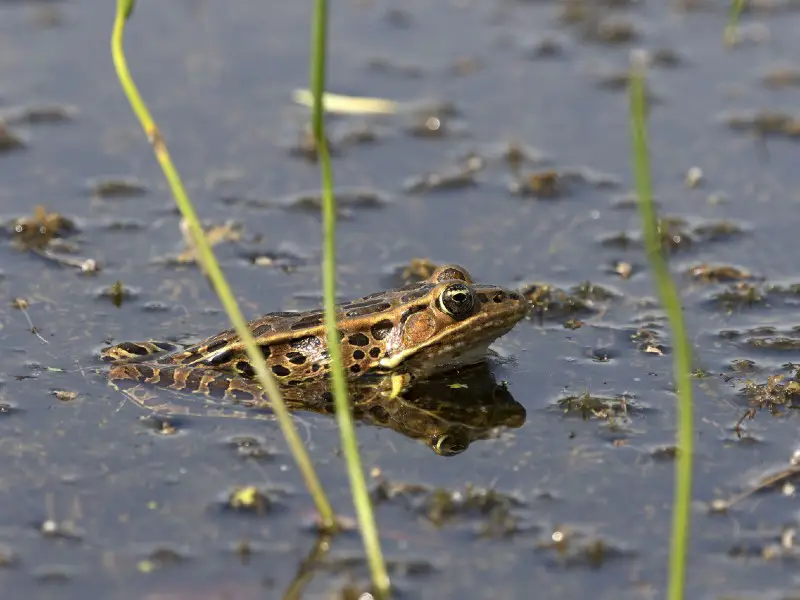
Leopard frogs don’t require much care. Some frog owners claim that these pets need only two hours of maintenance a week. Once you understand how to care for a leopard frog, these amphibians make a great introduction to the hobby of frog-keeping.
Food and Water
Leopard frogs eat a variety of insects, mostly crickets. You can feed your leopard frog fly larvae, earthworms, moths, and roaches. Feed young frogs a daily meal of 3–4 crickets. Once the frogs reach maturity, feed them every other day. Try and feed your pets a varied diet with different types of suitable insects.
Frogs are opportunistic eaters. This means that they’ll eat whenever prey comes near. This behavior is fine in the wild, where prey is scarce. However, a frog that eats whatever food it sees will likely get overfed by a worried owner in captivity. If your frogs are getting larger and rounder, you should reduce their food intake.
Leopard frogs drink from the water they bathe in. If you use a container as your water area, changing the water should be simple. Lift out the container and put in fresh water. You should then do a 50–75% water change and replace the container. Keep the water fresh because stagnant water will lead to disease.
Handling
Leopard frogs can be handled, and captive frogs will get used to it quickly. However, frogs don’t like being handled, and your frog may hide or try to jump away.
Be careful when opening the enclosure lid. Leopard frogs are excellent jumpers and notorious escape artists. Pick your frog up carefully. Frogs’ bodies are delicate, and our natural instinct is to squeeze tighter when we feel the frog trying to escape.
Keep handling sessions short and limit these sessions to once a week. This will help the frogs to get used to being held without getting stressed.
Wash your hands thoroughly before and after handling a leopard frog. Although leopard frogs don’t secrete toxins dangerous to humans from their skin, diseases and infections can still be spread between a person’s hands and a frog’s skin.
Do not allow children to handle frogs. Not only could this be a hygiene concern, but children are loud, excitable, and rough with their pets. This will seriously stress out a frog.
Being handled too frequently or too roughly, or being carried around too much will also stress out a leopard frog.
Common Health Issues
Leopard frogs are prone to two common frog conditions.
Fungal Infections
Fungal infections can be caused by dirty water, decaying insects, or too much stress or handling. Fungal infection usually presents itself as a cottony substance on the skin or as a noticeably inflamed area.
Fungal infections can be treated but need to be dealt with by a qualified vet. If one of your frogs develops a fungal infection, you should fully clean the tank from top to bottom, removing all substrate and doing a complete water change. You should quarantine the affected frog until it recovers.
Red-Leg Disease
If your leopard frog has red-leg disease, you’ll notice your frog’s legs looking red and inflamed, and the frog will be lethargic. Red-leg disease can be treated by a qualified professional. If you notice any worrying symptoms, take your frog to a qualified vet immediately.
Breeding
Breeding leopard frogs is an easy process. The frogs reach sexual maturity at two years of age, and the male frogs start to “sing,” making a mating call to attract the females. The frogs should mate without any necessary prompting or special conditions if they’re healthy and happy in their enclosure.
If the breeding is successful, you’ll notice eggs in the water area of the tank, which will hatch into tadpoles. If you have aquatic plants, the eggs will be attached to them. Tadpoles eat algae and rotting vegetable matter as they grow, although not all may grow to maturity. This is normal, as frogs usually lay hundreds of eggs, and there will be hundreds of tadpoles.
Choosing and Buying a Leopard Frog
Leopard frogs are popular pets. You can buy a type of leopard frog from most exotic pet dealers at the cost of between $10 and $25, depending on how rare the species is. You should always buy your pets from an established, reputable breeder.
When choosing a leopard frog, look for a frog with clear skin and eyes. Don’t worry if the frog doesn’t seem active, as this is normal for a frog.
Leopard frogs are interesting and easy to care for. Leopard frogs are fun pets, and while you can’t handle them as much as you can handle other animals, these frogs bring excitement and character to a home.

